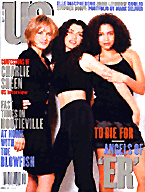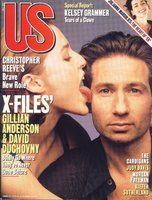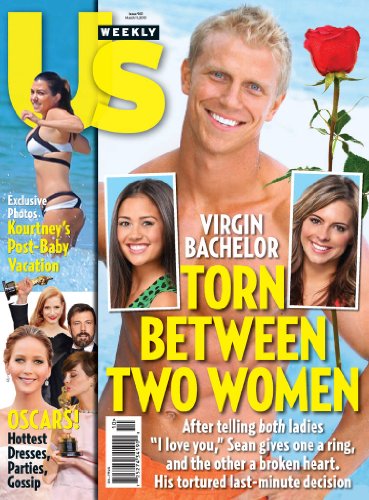Today’s Guest: Barbara O’Dair, editor, US Magazine


Originally published June 23, 1997
My first inkling that something was different about US magazine came as I settled into an airplane seat and reached into my briefcase for something to read. The airport newsstand was pretty thin and I had reluctantly settled for US.
On the cover was Sandra Bullock, an actor who doesn’t exactly get my pulse racing. But as I settled in for the two-hour flight, I began turning the pages.
I’m not a big reader of celebrity gossip magazines. People magazine does nothing for me; the only advantage US had over it until recently was color inside photos. But as I read on, it dawned on me that much had changed at Rolling Stone‘s little sister magazine.
US shocked me with the number of pages it devoted to terrific photographs of its cover subject. And the story was lively and funny, letting Bullock be herself in a way few interviews do. Even more pleasing was the sheer volume of good stuff throughout the magazine. By the time we landed in Tampa, I had read US from cover to cover.
Two months later, I intentionally picked up the magazine. This time Jennifer Aniston, co-star of the NBC sitcom “Friends,” was on the cover. Just as it did with Bullock, the magazine devoted several pages to eye-catching photos of Aniston and followed it with another well-written profile.
The clincher came with the May issue, featuring Gillian Anderson of Fox’s “The X-Files” taking a big lick of her co-star David Duchovny’s face. A little gross, true, but the cover story offered a ticklish interview of the two stars together, something few other publications have managed.
US began life as a New York Times magazine until Rolling Stone founder Jann Wenner bought it eight years ago. Today, the magazine is a certifiable success, selling 1.1 million copies monthly, half via subscription and half at the newsstand.
Forced to admit I, too, was hooked, I called US magazine editor Barbara O’Dair for an interview. O’Dair, 37, already a veteran editor of Rolling Stone, Men’s Journal, Entertainment Weekly and the Orange County Register, is also the editor of a forthcoming collection of essays titled, The Rolling Stone Book of Women and Rock: Trouble Girls (Random House).
In the spirit of her magazine, which makes an art of Q & A-style interviews, here are highlights of our conversation:

O’DAIR: No, it has changed a lot. Jann Wenner deputized me to conceive of and enact this new vision for the magazine. We introduced a lot of new features.
Editorially, what is different today than say three or four years ago?
O’DAIR: I think we improved the quality of the writing and, particularly, the photography. We signed up a number of top photographers, including Mary Ellen Mark, Mark Seliger, Matthew Rolston and Ruben Afanador. And we introduced “Portfolio,” which is a collection of five or six fabulous photographs of a subject or subjects that often functions as a story in itself, in addition to whatever text that accompanies the piece.
The first one was the Brad Pitt portfolio, which featured Brad Pitt on the cover in October 1995. We have put at least one, sometimes two, portfolios in every issue.
I really like the use of the photos. Daily newspapers, most of whom have color reproduction and great staff photographers, never feature their art.
O’DAIR: I think it has definitely gotten people to look at US in a new light, and that feels really good. We are taken more seriously because we show that we care about good photography and that we care about our subject matter. We don’t trade in cheap imagery.
The other thing that really impressed me was the frequent use of Q & A.
O’DAIR: Since its inception, US has had an interview which was kind of modeled on the Playboy interview. That has been an earmark of every issue. We do it with controversial subjects and people who are chatty and people who are funny. People want to hear from this person and not so much from the writer. We also cluster a series of one-page Q & As at the back of the book.
I thought that the Woody Allen Q & A was just about the best thing that I have read with him actually talking about what has been going on in his life.
O’DAIR: You get it from the horse’s mouth. We had a really good Q & A with Charlie Sheen, a star who is not exactly bright at the moment but who gives really good quotes. You get the sense of what these peoples’ lives are like, the kinds of decisions they make on a daily basis and how they are like you and me and how they are not like you and me at all. All those similarities and differences become crystal clear.
Basically, the goal is just a great, riveting read. Some Q & As are not as easy to do as some people might think; you don’t turn on the tape recorder and then transcribe. It is an art in itself to make it lively and fun, while probing the subject with angled questions.
Who is the magazine’s competition today? Is it still People, or is it broader than that?
O’DAIR: Everybody who puts a celebrity on their cover, basically — Vanity Fair, Entertainment Weekly, In Style, People, Premiere and Interview. On the high end, we are looking to nip some heels at Vanity Fair, and I think we do that pretty successfully from time to time. I think we used to be confused more often with People than we are now. Our mandate is really pretty different from People.
How so?
O’DAIR: For one thing, they are a weekly. They respond to people in the news in a different way than we do, and they also, for better or worse, on a case by case basis, often do stories without access to the people they are writing about. You know what I mean. They are taking a different tack. I think they do what they do very well, but we are rarely jockeying for the same cover.
There has been much discussion in recent years about how celebrities’ press agents control stories, making demands about who conducts interview and is authorized to take photos. Have you experienced that at US, and if so, how do you deal with it?
O’DAIR: We have experienced it ever since I got into this business 10 years ago, and it became more and more intense as the years go by. We try to hold our ground. I can’t say that we have never talked with a publicist about a photographer that will be acceptable to both parties, us and them, but we never let them dictate. We never let them say, ‘Well, you can have Meg Ryan for your cover if she is shot by so-and-so.’ We come up with the photographers and the writers and if, for some reason, they are not acceptable, if they committed some grave offense against the subject, obviously, we don’t want bad chemistry, because we are not looking to enrage people. But we really need to be trusted on our editorial choices, and we make that very clear to the publicists. For the most part, they respect that. If we can’t come to terms, we drop it. We have walked away a number of times.
Do you often fight with People or Entertainment Weekly over exclusive interviews?
O’DAIR: Well, we insist on exclusivity when we can. We don’t want to appear with the same cover subject in the same month as one of our main competitors.
How much can you control that?
O’DAIR: Well, we ask them, and we make deals, and if they say, well, sorry, but Mr. X is going to appear on three other magazines, then we don’t go there. It is as good as saying this person is not available. So basically, it is a race to get to these people first and to commit, but you can’t over-commit for a year down the line, because with movies, for example, release dates are changing constantly. The Jennifer Anniston cover in March was originally timed to a movie called Picture Perfect which is now coming out this summer. Fortunately, it didn’t really matter, because she is a TV star on every week.
The May issue of US featured an “X-Files” cover story that was worth the price, but it also offered an extraordinary Kelsey Grammer piece and a cheeky profile and portfolio of Julianna Margolis . . .
O’DAIR: Well, thank you. The Kelsey Grammer story was something we were really proud of. That writer sweated it, because it was not a publicist-pleasing story. But I think it was a story that was very good for us, and in the end, I don’t think we did any disservice to the guy. I think we basically just told it as it was.
Tell me about your new book, The Rolling Stone Book of Women and Rock: Trouble Girls.
O’DAIR: Oh, a completely different topic! (She laughs.) That project actually originated when I was still at Rolling Stone. It was a book that I wanted to do since I was in college, and when it became clear to me that I really was working at Rolling Stone, I thought, well, gee, I ought to make this work in more ways than one.
What will the book consist of?
O’DAIR: Basically, I commissioned more than 50 original essays written by women about women and rock, from the blues up to the present day.
It sounds like a real interesting project.
O’DAIR: Rolling Stone has a long history of putting out great resource books such as The Rolling Stone Illustrated History of Rock & Roll. This is somewhat modeled on that, although it is specifically women on women.

 The Party Authority in New Jersey, Pennsylvania, Delaware and Maryland!
The Party Authority in New Jersey, Pennsylvania, Delaware and Maryland!

Leave a Reply